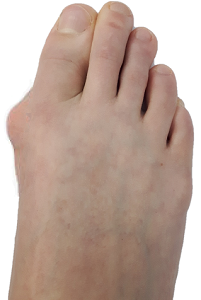
Bunion and Hallux Valgus
What are Bunions?
Bunions are a bony deformity on the side of the big toe joint (1st MTP joint). It can be accompanied with or without the deviation of the toe (hallux valgus). When the bunion or hallux valgus begins to develop, it is important to address the cause and prevent them from worsening.
Bunion vs Hallux Valgus
The bunion is the bony deformity on the side of the joint and hallux valgus is the actual deviation. The hallux valgus is commonly present with the bunion, but there can be one without the other.
Causes
The hallux valgus may cause the bunion to develop. When the hallux (big toe) deviates towards the other toes, strain to the MTP joint (big toe joint) occurs. With strain at the MTP joint, the body develops bone to strengthen the joint. The hallux valgus may develop and/or worsen due to footwear, mechanical factors or genetics.
Footwear
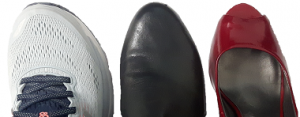
With improper fitting footwear, the hallux (big toe) gets pushed towards the smaller toes. These kinds of shoes have a narrow toe box or a narrower width than required. The toes are squished together, leading to an exaggeration to the hallux valgus. These kinds of footwear can also lead to conditions like Morton’s Neuroma.
Mechanical Factors
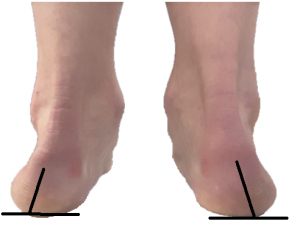
Overpronation and/or flat feet commonly cause a medial (inside) toe off, which leads to a bunion. When every step of the foot pushes the hallux towards the smaller toes, the hallux will slowly deviate over time. The larger the deviation, the more the angles of the structures attaching to the hallux will change and encourage further deviation.
Hypermobility (excessive motion) in the feet may also lead to a bunion. Hypermobility causes the 1st MTP joint to rub against the inside of the shoe while walking. This friction to the 1st MTP joint causes the body to react by strengthening the area and growing bone.
Genetics
Genetics may play a role in the development of the bunion. The genetics may be related to the mechanical factors or have only a small mechanical role. Different family members may have varying severities of the bunion and hallux valgus. This is due to the other factors mentioned above.
What will I see and feel?
The starting stages of a bunion present as redness and/or pain to the 1st MTP joint (big toe joint) 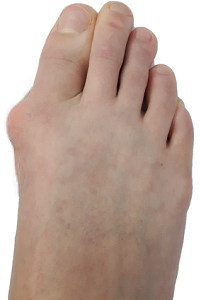 and/or swelling to the area. This indicates pressure or strain where there should not be. This may or may not be accompanied by a slight deviation of the hallux (big toe). This redness and/or pain may only be present while wearing shoes, or occur barefoot as well.
and/or swelling to the area. This indicates pressure or strain where there should not be. This may or may not be accompanied by a slight deviation of the hallux (big toe). This redness and/or pain may only be present while wearing shoes, or occur barefoot as well.
Later stages of the bunion will reveal a large bump on the inside of the 1st MTP joint. This may cause issues and pain when fitting into footwear. If the hallux (big toe) deviates far enough, the second toe may cross overtop of the hallux. This second toe may develop redness on the top due to pressure and shear from a shoe.
Treatments
Removal – Surgery
The only way to completely remove the bunion is through surgery. Generally, they shave off the bunion/bone and realign the hallux valgus (if applicable). If the original cause of the bunion is not addressed, the deformity will likely return again.
Prevention – Orthotics and Footwear
Bunion prevention through orthotics and proper footwear is important at all stages of the bunion. These types of interventions help slow down or stop the progression of the bunion, relieve pain and/or prolong surgery intervention. The level of effectiveness in prevention depends on the cause of the bunion. When a genetic factor is not related to mechanical factors, the intervention may not completely stop progression.
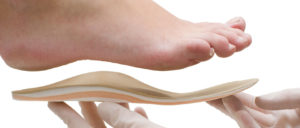 Orthotics help with the bunion by supporting the foot and dealing with the mechanical causes. Arch support and posting to angle the foot shift the pressure from the inside of the hallux to the middle of the foot. Custom orthotics and over the counter inserts provide this support to varying degrees.
Orthotics help with the bunion by supporting the foot and dealing with the mechanical causes. Arch support and posting to angle the foot shift the pressure from the inside of the hallux to the middle of the foot. Custom orthotics and over the counter inserts provide this support to varying degrees.
There are important features in footwear to help prevent pressure and irritation at the bunion and hallux. These features are a wider width, a wide toe box, a deep toe box and stretched areas at the bunion location. The deep toe box becomes important when the second toe crosses over the hallux (big toe) to prevent second toe irritation.
If this sounds like the condition you have, or you would like more information, let us know!

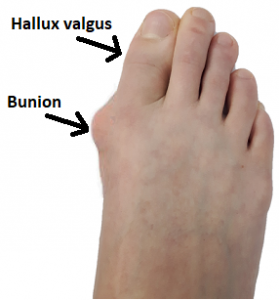
You must be logged in to post a comment.